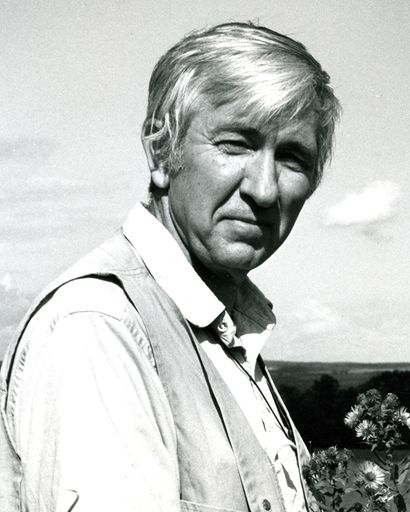

Richard B. Root
d. January 22, 2013
Richard Bruce Root, known to his friends as Dick, passed away quietly in his wife’s arms at the Beechtree Care Center in Ithaca, NY just after midnight, January 22nd 2013. He was in the final stage of a degenerative disease, which he lived with for seven years with a grace and fortitude that was an inspiration to everyone around him.
Dick was born in 1936 to Charles Augustus Root and Doris Jewell Root at a small hospital outside Dearborn, MI. He attended a one-room schoolhouse for two years before moving to Plymouth, MI where, in his own words he “was often in trouble with the teachers.” As an only child, he worked the family farms with both grandfathers, and spent a lot of time alone in nature. Before Dick was even eight years old, he developed an interest in what he described as “how the woods ‘worked.’ ”
When he talked about this interest, nobody of his acquaintance had heard of such a thing and he was steered toward forest management. “It was something of a relief,” he wrote, “when I discovered the word ‘ecology’ a few years later.” Through Boy Scouts he managed to spend whole summers away from home or camping out along the creek that ran through the woods near Plymouth. “These summers free of adults and in the woods were very happy times and probably had a major bearing on my personality.” In high school, Dick assisted Arthur Sinclair, “my first great teacher,” at the Howell Boy Scout Reservation, teaching the other scouts nature, bird study, forestry and wildlife conservation.
At the University of Michigan for biology, Dick’s precocity is obvious from his own journal entries: “Frederick E. Smith [Dick’s undergraduate advisor] turned over half of his own office for me to use in my study of triclad life tables.” And “I was very lucky to be part of a stimulating cohort of graduate students in ecology who were willing to include an undergraduate in their group.” At the end of his junior year Dick married Betsy Eichstedt, who was studying fern taxonomy. They had their first child, Jenny, while Dick was a graduate student at the University of California at Berkeley.
Dick’s doctoral thesis, “The Niche Exploitation Pattern of the Blue-Gray Gnatcatcher,” formed the basis for his development of “the guild concept,” a contribution that became such a cornerstone of contemporary ecology that people don’t even bother citing him anymore. This excellent work led to a teaching job at Cornell University straight out of graduate school. That job offer came while he was in the delivery room where his son, Bryan, was being born.
In 1964 he moved his family to Ithaca, NY where he would spend his entire career teaching graduate and undergraduate biology and ecology at Cornell. In the seventies, in an effort to find harmony in his personal life, Dick took up transcendental meditation briefly before embracing Zen Buddhism. He studied in Cali Colombia for a year, on a Rockefeller grant and spent six months at the Hastings Reservation in California studying milkweed. Dick and Betsy separated in 1978, just after their oldest child left the nest.
He spent the next ten years as a single father, dating and then marrying Barbara Page Cooke, an artist and the mother of his stepsons, George and Paul. His marriage to Barbara marked a big change in Dick’s life. Her art and his science were of mutual interest and they both flourished. Barbara’s paintings are the basis of three permanent scientific exhibits, "Rock of Ages, Sands of Time," at the Museum of the Earth in Ithaca, NY and two similar presentations at the North Carolina Museum of Natural Sciences in Raleigh. In 1985 Dick was elected president of the Ecological Society of America. That same society gave Dick the Eminent Ecologist Award in 2003, and in 2004 he received the Eugene P. Odum Award for outstanding work in ecology education.
Dick was both a field (outdoor) ecologist and a contributor to theoretical and conceptual issues in ecology. Dick was a superb naturalist who embraced a simple, observational approach to nature study, and his studies focused on insects and plants. But he also understood the need to perform experimental manipulations in order to elucidate the underlying causes of patterns in nature. For example, by experimentally preventing insects from feeding on goldenrod plants in a local meadow, he showed that the goldenrods grew noticeably taller and produced more flowers, thus demonstrating the large effects of the insects. Dick worked on agricultural systems and showed that they are interesting communities in their own right but they can also serve as analogs for the interactions and processes that occur in natural communities. Most recently he studied old field goldenrods and their insect fauna. Based on these studies Dick proposed that a helpful way to think about how natural communities are organized is to focus on the common plant species and their associated insects. These are the building blocks of natural communities. Over his career, Dick published many influential papers that combined his interests in theoretical and natural history studies of communities.
Dick is survived by his wife, Barbara Page; his children, Jenny McGuire and Bryan Root; his stepsons, George and Paul Cooke; his grandchildren, Rosa Puryear Fox and Nicole McGuire Gilbert, as well as six other grandchildren and step-grandchildren and three great-grandchildren. His legacy as a teacher puts him at the base of a huge, branching tree of graduate students and great-graduate students who have gone on to become important scientists, authors, and teachers. He will be remembered both as a brash young academic who could swear like a longshoreman, and as the sweet and dignified scholar he later became. We will miss his advice, his wit, and his tendency to weep during his own anecdotes about people and things close to his heart. And, perhaps most of all, we will miss his laughter, which was loud and deeply felt.
There will be a memorial for Dick on Saturday, February 2nd, 2013 at 2pm at the United Methodist Church, 80 East Main St, Trumansburg, NY. The public is invited. Those who wish to remember him in the form of contribution are asked to consider the Finger Lakes Land Trust, http://fllt.org/contribute/, or Hospicare, http://www.hospicare.org/donate/.
Guestbook
Visits: 12
This site is protected by reCAPTCHA and the
Google Privacy Policy and Terms of Service apply.
Service map data © OpenStreetMap contributors



